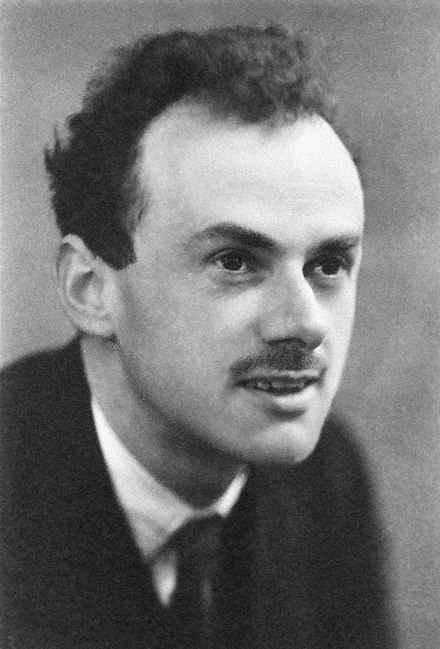
Paul Adrien Maurice Dirac OM FRS; 8 August 1902 – 20 October 1984) was an English theoretical physicist who made fundamental contributions to the early development of both quantum mechanics and quantum electrodynamics. He was the Lucasian Professor of Mathematics at the University of Cambridge, a member of the Center for Theoretical Studies, University of Miami, and spent the last decade of his life at Florida State University.
Among other discoveries, he formulated the Dirac equation which describes the behaviour of fermions and predicted the existence of antimatter. Dirac shared the 1933 Nobel Prize in Physics with Erwin Schrödinger "for the discovery of new productive forms of atomic theory". He also made significant contributions to the reconciliation of general relativity with quantum mechanics.
He was regarded by his friends and colleagues as unusual in character. Albert Einstein said of him "This balancing on the dizzying path between genius and madness is awful".
He is regarded as one of the most significant physicists of the 20th century. Wikipedia, Paul Dirac
Paul Dirac wasn't just a brilliant theoretical physicist; he was a man whose very presence sparked fascination and bewilderment. Often referred to as “the strangest man in the world” by his colleagues, this title was coined by Niels Bohr, who had the privilege—and challenge—of working with Dirac. Their relationship, initially professional, eventually blossomed into a human bond marked by moments that only someone like Dirac could inspire.
Dirac’s brilliance wasn’t just in his groundbreaking contributions to physics, but in his extraordinarily peculiar approach to life itself. His communication style was as precise and unembellished as his theories. Niels Bohr, struggling to complete a scientific paper, once confessed, “I don’t know how to go on.” Dirac, ever the purist in logic, responded coldly, “I was taught in school that you should never start a sentence without knowing the end.”
And this stark, almost robotic demeanor wasn’t limited to his work. At one dinner, a fellow guest casually remarked, “Nice evening, isn’t it?” Dirac, without missing a beat, stood up, walked to the window to check the weather, and returned with the uncharacteristically succinct reply: “Yes.”
But it was his social awkwardness that painted him as the quintessential oddball. At a Copenhagen party, Dirac proposed a theory on the optimal distance from a woman’s face at which it appears most attractive—backed by his own research, of course. His response to a curious colleague’s question about his personal experience was both absurd and perfectly Dirac: “About that close,” he said, holding his palms about a meter apart.
Then there was the famous incident at the University of Toronto, when, after delivering a lecture, he was asked a question by a student. Dirac’s response? “This is not a question, it is an observation. Next question, please.”
Yet, despite all his brilliance, Dirac's discomfort with philosophy, literature, and even religion was profound. He dismissed poetry as “saying something that everyone already knows in words no one can understand” and offered a scathing critique of religion, claiming that scientists must acknowledge its absurdity. In Dirac’s worldview, God may have used extraordinary mathematics to create the universe, but it was Dirac who, humorously, became known as "His prophet," according to his contemporary Wolfgang Pauli.
In every moment, Dirac's life seemed to blur the line between genius and eccentricity, leaving those who encountered him to wonder: was he a physicist of the highest order, or simply the strangest man to ever walk the earth?
See Also
Bearden - Precursor Engineering: Via Tickling of the Dirac Sea Vacuum
Dirac equation
Dirac Sea
ether
Russell to NYT - 1930 November 2
Schrodinger equation
